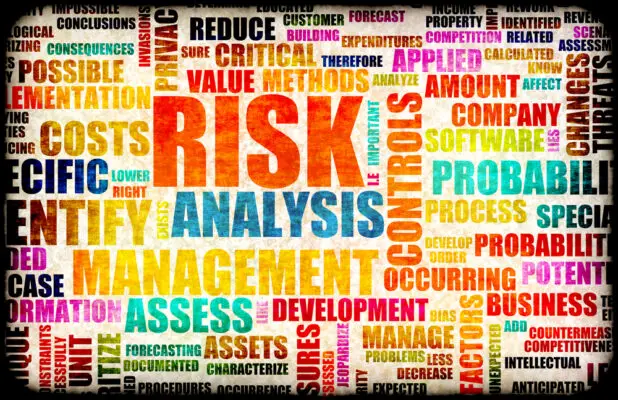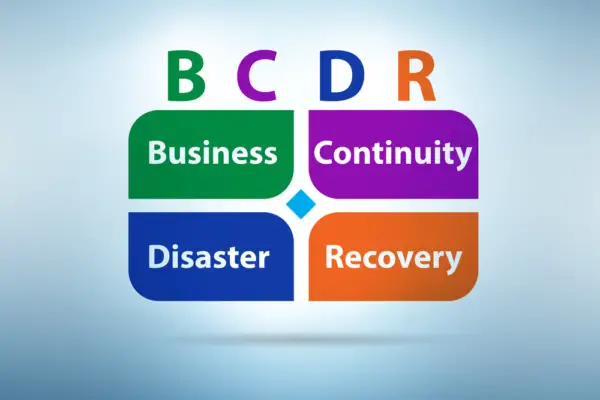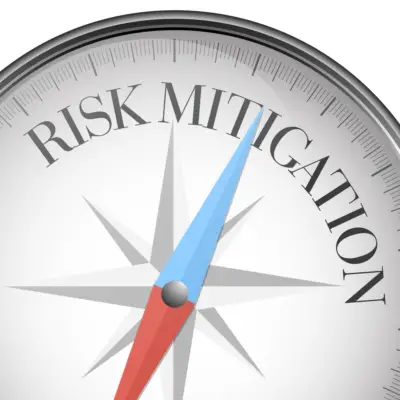Business continuity involves four critical phases for resilience: identification of risks, risk analysis, strategy design, and plan development and execution. In the identification phase, risks are pinpointed. Risk analysis involves evaluating potential threats and impacts.
Strategy design focuses on devising mitigation strategies. Plan development and execution entail creating a detailed continuity plan and putting it into action.

Each phase is crucial in fortifying an organization against disruptions. Understanding these phases is key to safeguarding business operations effectively. More insights await on the journey of fortifying business resilience.
Key Takeaways
- Risk Assessment and Analysis.
- Risk Mitigation and Strategy Development.
- Continuity Plan Implementation and Testing.
- Testing and Measurement for Continuity.
- Continuity Plan Evaluation.
Identification of Risks
The identification of risks is a pivotal starting point in business continuity planning. It involves conducting a thorough risk assessment to pinpoint potential hazards and vulnerabilities.
Risk Assessment Importance
How significant is the role of risk assessment in identifying potential hazards that could disrupt business operations? Risk assessment plays an essential role in business continuity by analyzing various potential threats, including natural disasters, human errors, and technical failures.
It involves conducting a business impact analysis (BIA) to determine the severity and duration of disruptions. Identifying critical operations, minimum resources, and dependencies is crucial for effective risk management. Understanding the impact of risks allows for prioritization and planning for mitigation strategies.
Senior management plays an important role in overseeing the risk assessment process to make sure that the organization is well-prepared to handle emergencies and disasters.
| Key Aspects of Risk AssessmentKey Aspects of Risk AssessmentKey Aspects of Risk Assessmenttential threats | Conducting a business impact analysis (BIA) | Identifying critical operations |
| Determining severity and duration of disruptions | Prioritizing and planning mitigation strategies | Involvement of senior management |
Vulnerability Analysis Methods
In the domain of business continuity planning, the process of identifying risks through vulnerability analysis methods is integral for ensuring operational resilience.
Vulnerability analysis methods in business continuity involve evaluating potential threats and vulnerabilities through techniques like risk assessments and impact analyses.
These methods help prioritize risks based on their impact, allowing organizations to develop strategies to effectively mitigate and manage identified risks.
By conducting vulnerability analysis, businesses can improve their continuity plan by understanding the critical areas that require attention in times of emergency or disaster.
This process aids in the management of risks, enhances preparedness, and contributes to the overall resilience of the organization.
Risk Mitigation Strategies
Effective risk mitigation strategies in business continuity planning involve a thorough assessment of potential risks that could disrupt the organization’s operations. To address this, organizations can implement the following strategies:
- Conduct a thorough risk assessment: Identify natural, human, and technical threats that could impact business operations.
- Perform a business impact analysis (BIA): Analyze the severity and duration of disruptions caused by each risk to prioritize mitigation efforts.
- Identify critical processes: Determine essential functions, required resources, and dependencies for effective risk mitigation.
- Develop interruption mitigation and recovery strategies: Plan for quick recovery from disruptions, including scenarios like power outages, through continuity management and emergency response protocols.
Risk Analysis
Risk analysis in business continuity is an important step that involves identifying potential hazards and threats that could impact operations.
By conducting a thorough risk assessment, businesses can determine the severity of each risk and its potential consequences.
This analysis informs the development of strategies to mitigate interruptions and prioritize recovery efforts for critical processes.

Identifying Potential Risks
As organizations begin the initial phase of business continuity planning, a thorough process of identifying potential risks through in-depth risk analysis becomes imperative. During this phase, the following key steps are essential:
- Comprehensive Risk Analysis: Evaluating natural, human, and technical threats that could disrupt business operations.
- Business Impact Analysis (BIA): Determining the severity and duration of disruptions caused by identified risks.
- Identification of Critical Processes: Recognizing essential operations, minimum resources, and dependencies.
- Understanding Risks’ Impact: Crucial for developing effective strategies to mitigate interruptions and ensure swift recovery.
Strategies for Risk
Strategically analyzing potential risks is essential for businesses to proactively safeguard their operations and guarantee continuity in the face of disruptive events.
Risk analysis involves identifying hazards and threats, evaluating their impact through a business impact analysis (BIA), and determining critical processes for recovery.
Implementing strategies for risk is vital to mitigate interruptions and guarantee swift recovery when a disaster strikes.
It is absolutely necessary to create a business continuity plan (BCP) as the next step after risk analysis, ensuring that business operations can proceed smoothly even in challenging circumstances.
Effective risk analysis helps identify gaps in current recovery capabilities, allowing businesses to plan efficiently and enhance their resilience against potential disruptions.
Strategy Design
Strategy design in business continuity planning is a critical phase that involves crafting a detailed and well-structured plan to guarantee the seamless continuation of operations.
This stage focuses on outlining the necessary strategies and procedures for effectively responding to disruptions, including managing critical processes, allocating resources, and maintaining communication channels during crises.
Risk Identification Methods
Effective risk identification methods in business continuity involve conducting thorough evaluations to pinpoint potential hazards that could impact the organization’s operations. To achieve this, several strategies are commonly utilized:
- Comprehensive Risk Evaluation: Analyzing natural, human, and technical threats that could affect the business.
- Business Impact Analysis (BIA): Determining the severity and duration of disruptions caused by identified risks.
- Identification of Critical Processes: Pinpointing essential processes, minimum resources, and dependencies for effective recovery planning.
- Prioritization of Mitigation Strategies: Evaluating the impact of potential risks on the business and prioritizing mitigation efforts.
These methods aim to enhance the organization’s resilience by proactively addressing risks and preparing for potential disruptions.
Robust Continuity Strategies
Crafting a precise and user-friendly business continuity plan is essential in creating a robust continuity strategy. Robust continuity strategies emphasize developing a well-organized plan that is easily accessible during disruptions. This involves documenting the plan concisely and in a format that is user-friendly.
Publishing, socializing, and training staff on the effective usage of the continuity plan are key components of these strategies.
Considering all potential users of the plan is crucial in designing robust continuity strategies. Effective strategy design guarantees that the plan is thorough, practical, and aligned with the business’s continuity needs.
Plan Development and Execution
During the Plan Development and Execution phase, organizations focus on implementing the continuity plan developed earlier, ensuring its effectiveness in real-world scenarios.
This phase involves testing the plan through various methods like checklists, walk-throughs, and simulations to identify strengths and areas for improvement.
Risk Identification Strategies
Conducting a thorough risk assessment is a foundational step in developing and executing risk identification strategies for business continuity planning. When identifying risks, several strategies can be implemented:
- Conduct a thorough risk assessment: Identify potential hazards and threats to the business.
- Perform a business impact analysis (BIA): Analyze the impact of each risk to determine severity and duration of disruptions.
- Identify critical processes and dependencies: Determine essential processes for recovery and minimum required resources.
- Develop mitigation strategies: Plan for interruptions and guarantee a prompt recovery process.
Regularly reassessing risks, impacts, and strategies is essential to maintaining an effective risk identification strategy in business continuity planning.
Continuity Plan Implementation
Implementation of the continuity plan involves meticulous testing procedures to guarantee operational readiness and efficiency in the face of disruptions. Various tests such as checklist tests, walk-throughs, and drills are conducted to ensure preparedness.
Additionally, a full recovery simulation test using actual equipment is performed to assess the plan’s effectiveness accurately. Based on the results of these tests, modifications to the plan are made to enhance its efficacy.
It is essential to regularly reassess risks, impacts, and strategies during this phase to adapt to evolving circumstances effectively.
By conducting thorough testing and refining the continuity plan, organizations can strengthen their resilience and ability to navigate through unexpected events, ensuring minimal disruption to operations.
Testing and Measurement
Testing and measurement are integral components of a robust business continuity plan. By evaluating the effectiveness of the plan through testing, organizations can identify strengths and areas for improvement.
Measurement further aids in determining the success of the strategy, ensuring operational resilience during disruptions.

Effectiveness of Testing
Effective testing is a critical component in evaluating the performance and reliability of a business continuity plan. To understand the effectiveness of testing, consider the following:
- Identification of Weaknesses: Regular testing helps pinpoint weaknesses and areas that need improvement in the plan.
- Functionality Assurance: Testing guarantees that the plan operates as intended during actual disruptions.
- Data for Improvement: Measurement during testing provides valuable data on response times and success rates.
- Enhanced Resilience: Effective testing leads to a more resilient and reliable business continuity strategy.
Continuity Plan Evaluation
To guarantee the operational resilience and efficacy of a business continuity plan, thorough evaluation through testing and measurement is essential.
Various tests such as checklist tests, walk-throughs, and drills are key components of this evaluation process. Conducting full recovery simulation tests using actual equipment aids in identifying areas for improvement within the plan.
It is important to modify the continuity plan based on the results of these tests to enhance its effectiveness. Regular reassessment of risks, impacts, and strategies is necessary to make sure that the plan remains relevant in the face of evolving business environments.
Continuity plan evaluation plays a critical role in fortifying an organization’s ability to navigate disruptions and maintain business continuity effectively.
Frequently Asked Questions
What Are the 4 R’s of Bcp?
The 4 R’s of BCP are Response, Relocation, Recovery, and Restoration. Response involves evaluating damage and determining actions during emergencies.
Relocation focuses on moving affected areas to safer locations. Recovery and Restoration guarantee operational continuity.
What Are the 4 P’s of Business Continuity?
The 4 P’s of Business Continuity are Prevention, Preparation, Response, and Recovery. Prevention involves risk identification and mitigation, Preparation focuses on creating a robust continuity plan, Response entails plan execution during crises, and Recovery aims at restoring operations.
What Are the 4 Phases of the Continuity Implementation Process?
The four phases of the continuity implementation process include Initial Response, Relocation, Recovery, and Restoration.
Initial Response assesses damage severity, Relocation involves moving affected areas, Recovery fixes the problem, and Restoration marks the return to normalcy.
What Are the 4 Elements of Business Continuity Plan?
The 4 elements of a Business Continuity Plan (BCP) include prevention, mitigation, response, and recovery phases. Prevention identifies risks, mitigation prepares response strategies, response activates the BCP, and recovery restores operations to normalcy.

Conclusion
The four key phases of business continuity – planning, response, recovery, and maintenance – are vital for organizations to effectively manage and recover from disruptions.
Identifying risks, analyzing them, designing strategies, developing and executing plans, as well as testing and measuring outcomes, businesses can proactively prepare for unforeseen challenges and guarantee operational resilience.
Maintaining a robust business continuity framework is essential for safeguarding long-term success and continuity in the face of adversity.

Chris Ekai is a Risk Management expert with over 10 years of experience in the field. He has a Master’s(MSc) degree in Risk Management from University of Portsmouth and is a CPA and Finance professional. He currently works as a Content Manager at Risk Publishing, writing about Enterprise Risk Management, Business Continuity Management and Project Management.

